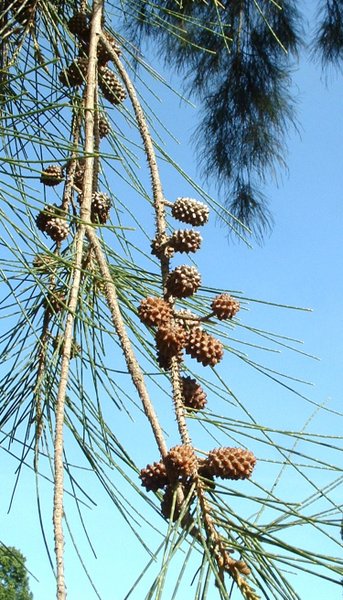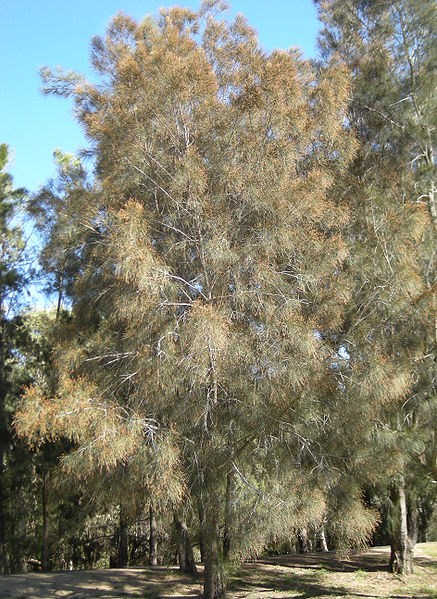 |
|
http://commons.wikimedia.org/wiki/User:Rickjpelleg |
 |
| http://commons.wikimedia.org/wiki/File:Casuarina_cunninghamiana_tree.jpg |
Translate this page:
Summary
Physical Characteristics

 Casuarina cunninghamiana is an evergreen Tree growing to 18 m (59ft 1in).
Casuarina cunninghamiana is an evergreen Tree growing to 18 m (59ft 1in).
See above for USDA hardiness. It is hardy to UK zone 9. It is in leaf all year, in flower from May to June, and the seeds ripen from September to December. The species is dioecious (individual flowers are either male or female, but only one sex is to be found on any one plant so both male and female plants must be grown if seed is required). . The plant is not self-fertile.
It can fix Nitrogen.
Suitable for: light (sandy), medium (loamy) and heavy (clay) soils and prefers well-drained soil. Suitable pH: mildly acid, neutral and basic (mildly alkaline) soils. It cannot grow in the shade. It prefers dry or moist soil.
UK Hardiness Map
US Hardiness Map
Synonyms
Plant Habitats
Woodland Garden Canopy; South Wall. By. West Wall. By.
Edible Uses
References More on Edible Uses
Medicinal Uses
Plants For A Future can not take any responsibility for any adverse effects from the use of plants. Always seek advice from a professional before using a plant medicinally.
None known
References More on Medicinal Uses
The Bookshop: Edible Plant Books
Our Latest books on Perennial Plants For Food Forests and Permaculture Gardens in paperback or digital formats.

Edible Tropical Plants
Food Forest Plants for Hotter Conditions: 250+ Plants For Tropical Food Forests & Permaculture Gardens.
More

Edible Temperate Plants
Plants for Your Food Forest: 500 Plants for Temperate Food Forests & Permaculture Gardens.
More

More Books
PFAF have eight books available in paperback and digital formats. Browse the shop for more information.
Shop Now
Other Uses
Dye Shelterbelt Soil reclamation Soil stabilization Tannin Wood
Gold, green and grey dyes are obtained from the leaves[156]. The bark can be used as tanbark[269]. The plant forms suckers and is a good soil stabilizer[156]. It is much planted in Egypt for protecting roads from the sand[269]. It is often planted along the sides of streams to protect them from erosion[269]. In suitable climates, the plant is much used in windbreaks, shelterbelts and for land reclamation[269]. Wood - dark, durable, closely grained, nicely marked, not as heavy as that of other members of this genus. Used for flooring, axe handles, firewood, poles etc[156, 269].
Special Uses
Food Forest Nitrogen Fixer
References More on Other Uses
Cultivation details
Requires a well-drained moisture-retentive soil in full sun[200]. Succeeds in most soils, whether well-drained or damp, in Australian gardens[157, 167]. The plant is reported to tolerate acid soils, alkaline soils, calcareous soils (perhaps chlorotic), drought, muck, sand dunes, salt, weeds, and wind[269]. Plants tolerate an annual precipitation in the range of 50 to 150cm[269]. This plant tolerates temperatures down to at least -7°c in Australian gardens[157] although this cannot be translated directly to British gardens due to our cooler summers and longer, colder wetter winters. It experiences severe frosts in parts of its range[167] and so some provenances should succeed outdoors in the mildest areas of this country. Plants have survived temperatures of -8°C with no apparent injury. They are said to tolerate up to 50 light frosts per year[269]. Closely related to C. glauca and often hybridises in the wild with that species[265]. This species has a symbiotic relationship with certain soil micro-organisms, these form nodules on the roots of the plants and fix atmospheric nitrogen. Some of this nitrogen is utilized by the growing plant but some can also be used by other plants growing nearby[157, 200]. Dioecious, male and female plants must be grown if seed is required. In garden design, as well as the above-ground architecture of a plant, root structure considerations help in choosing plants that work together for their optimal soil requirements including nutrients and water. The root pattern is suckering with new plants from underground runners away from the plant [2-1].
References Carbon Farming Information and Carbon Sequestration Information
Temperature Converter
Type a value in the Celsius field to convert the value to Fahrenheit:
Fahrenheit:
The PFAF Bookshop
Plants For A Future have a number of books available in paperback and digital form. Book titles include Edible Plants, Edible Perennials, Edible Trees,Edible Shrubs, Woodland Gardening, and Temperate Food Forest Plants. Our new book is Food Forest Plants For Hotter Conditions (Tropical and Sub-Tropical).
Shop Now
Plant Propagation
Seed - sow late winter to early summer in a greenhouse and only just cover the seed[138]. When they are large enough to handle, prick the seedlings out into individual pots and grow them on in a greenhouse for at least their first winter. Plant them out into their permanent positions in late spring or early summer, after the last expected frosts. There are 440,000 - 550,000 seeds per kilo[269]. Cuttings of half-ripe wood, July/August in a frame[157, 200].
Other Names
If available other names are mentioned here
Native Range
AUSTRALASIA: Australia, New South Wales (east), Queensland (east), Northern Territory (north),
Weed Potential
Right plant wrong place. We are currently updating this section.
Please note that a plant may be invasive in one area but may not in your area so it's worth checking.
Conservation Status
IUCN Red List of Threatened Plants Status :

Growth: S = slow M = medium F = fast. Soil: L = light (sandy) M = medium H = heavy (clay). pH: A = acid N = neutral B = basic (alkaline). Shade: F = full shade S = semi-shade N = no shade. Moisture: D = dry M = Moist We = wet Wa = water.
Now available:
Food Forest Plants for Mediterranean Conditions
350+ Perennial Plants For Mediterranean and Drier Food Forests and Permaculture Gardens.
[Paperback and eBook]
This is the third in Plants For A Future's series of plant guides for food forests tailored to
specific climate zones. Following volumes on temperate and tropical ecosystems, this book focuses
on species suited to Mediterranean conditions—regions with hot, dry summers and cool, wet winters,
often facing the added challenge of climate change.
Read More
Expert comment
Author
Miq.
Botanical References
200265
Links / References
For a list of references used on this page please go here
Readers comment
| Add a comment |
|
If you have important information about this plant that may help other users please add a comment or link below. Only comments or links that are felt to be directly relevant to a plant will be included. If you think a comment/link or information contained on this page is inaccurate or misleading we would welcome your feedback at [email protected]. If you have questions about a plant please use the Forum on this website as we do not have the resources to answer questions ourselves.
* Please note: the comments by website users are not necessarily those held by PFAF and may give misleading or inaccurate information.
To leave a comment please Register or login here All comments need to be approved so will not appear immediately.
|
Subject : Casuarina cunninghamiana
|
|
|
|